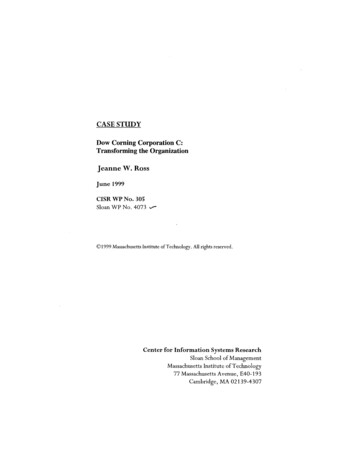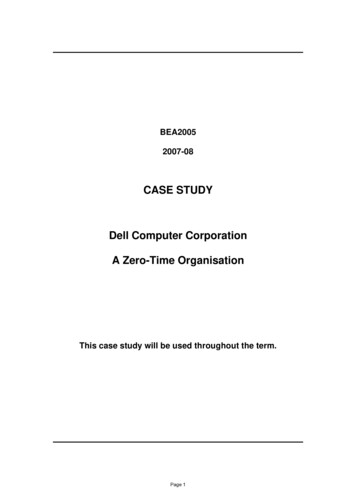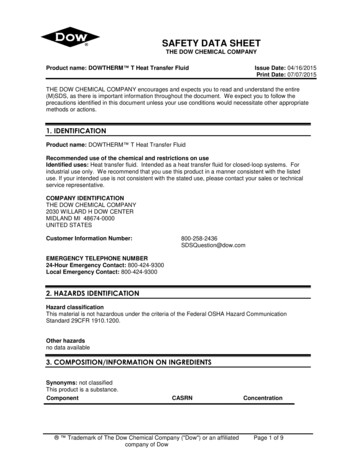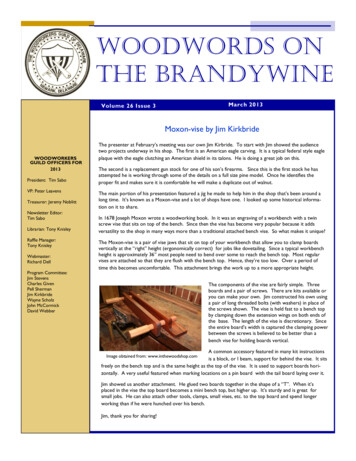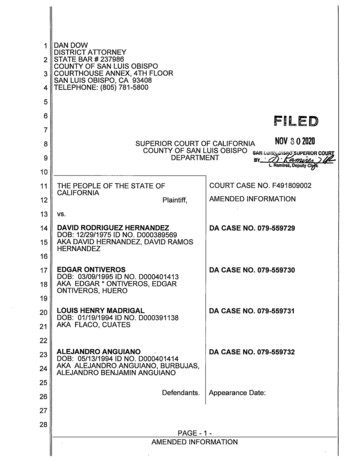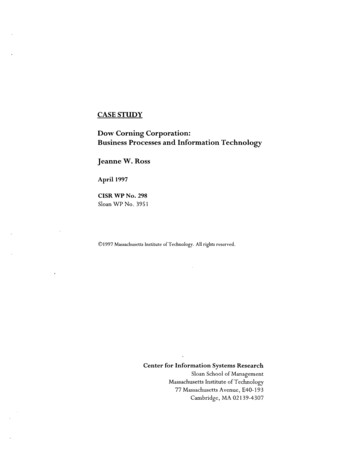
Transcription
CASE STUDYDow Corning Corporation:Business Processes and Information TechnologyJeanne W. RossApril 1997CISR WP No. 298Sloan WP No. 3951(1997 Massachusetts Institute of Technology. All rights reserved.Center for Information Systems ResearchSloan School of ManagementMassachusetts Institute of Technology77 Massachusetts Avenue, E40-193Cambridge, MA 02139-4307
TITLE:CASE STUDY-Dow Corning Corporation:Business Processes and Information TechnologyAUTHOR:Jeanne W. RossDATE:April 1997ABSTRACT: This case study, divided here into parts (A) and (B), describes one firm's experiences as it adopted a process perspective to managing its business, examined the implications forits information systems needs, decided to acquire SAP, an integrated, enterprise-wide softwarepackage, and embarked on the SAP implementation.Dow Corning Corporation(A): Business Processes and Information Technology focuses on thebusiness context and describes the role and structure of the information technology (IT) functionat Dow Coming in late 1994. In the midst of a legal crisis that is draining financial resources, thefirm must address global competition. The case poses the question of how should IT beorganized and managed to meet current business challenges.Dow Corning Corporation(B): Reengineering GlobalProcesses is set in March 1997. The ITorganization has been redesigned and reports to a member of the senior management team. Thecase focuses on Dow Coming's pilot implementation of SAP and its plans to reengineer globalprocesses. Special attention is given to the IT unit's role in the reengineering and systemsimplementation processes.27 PagesThis paper is also available from the Sloan Working Paper Series as Sloan Working Paper No. 3951.
UCenter for Information Systems ResearchSloan School of ManagementMassachusetts Institute of TechnologyDow Corning Corporation (A): Business Processes and Information TechnologyIntroductionIn October 1994, Dick Hazleton, CEO of Dow Coming Corporation, was considering actions thatcould significantly affect the organization, staffing, and role of the Information Technology (IT)function in the company. Hazleton and other senior managers had agreed it was imperative tointroduce major improvements in operational efficiency through a process-centered organization,not only to increase cash flow but to best position the company for long-term competitiveness.They knew instinctively that IT could play a major role in enabling operational changes, but wereuncertain of just how that would occur or how it should be organized and managed. Hazletonwanted to move quickly, but knew the success of radical operational and work changes dependedon the full support of his Operating Committee of sixteen senior managers and the support ofevery employee.BackgroundDow Coming Corporation was founded in 1943 as a jointly owned enterprise by The DowChemical Company and Coming Incorporated to develop the potential of silicone materials. DowComing's principal businesses were silicone materials and polycrystalline silicon. Silicones arechemical compounds based on silicon, an element refined from quartz. Silicone products varyfrom fluids used for antifoams and lubricants; elastomers used as building sealants, gaskets, andpacemaker leads; and resins applied as protective coatings. The corporation also manufacturedhigh purity polycrystalline silicon, the principal intermediate material for semiconductor chips.In 1994 Dow Coming had sales of 2.2 billion, approximately 8,300 employees andapproximately 45,000 customers worldwide (see Exhibit A-l). It operated out of 29manufacturing facilities on five continents, with greater than 50% of its sales generated outsidethe United States. The company was headquartered in Midland, Michigan, USA, with regionalheadquarters in LaHulpe, Belgium and Tokyo, Japan. The firm emphasized eight core values:integrity, customers, employees, safety, technology, quality, environment, and profit (see ExhibitA-2). Each year an internal publication reported key metrics on the status of each of these values.Dow Coming developed, manufactured, and marketed almost 5,000 silicone products and relatedspecialty chemical materials. Seven to eight percent of sales revenues were regularly devoted toresearch and development, and in 1994, twenty percent of revenues were from productsThis case was preparedby Jeanne Ross at the MIT Centerfor Information Systems Research. The author would liketo thank Chuck Gibsonfor his helpful direction and comments, and Charlie Lacefield, Marian Cimbalik, and theother Dow Corning employees who contributed insights, cooperation,and support. 1997Massachusetts Institute of Technology
introduced in the last five years.1 Dow Coming had long competed with large regional and globalcompanies, such as Shin-Etsu in Asia, Rhone Poulenc and Wacker in Europe and the U.S., andGE globally, but newer niche players were increasing the pressure on both quality and price. Atthe same time, Dow Coming's customers were demanding faster cycle times and greaterresponsiveness to unique needs. Management perceived both economies of scale and customerresponsiveness would be essential in order to remain competitive in the global marketplace.In 1976 top management introduced a unique multidimensional organizational structure thatrecognized the diverse demands of business, geographical area, and function. Dow Comingsuccessfully used this structure, which gave most professionals multiple bosses, while other firmswere failing in their efforts to establish matrixed reporting relationships. Industry experts creditedthis structure with providing a major competitive advantage.The matrix structure allowed Dow Corning to view itself by business group, geographical area,or specific function. It had two business groups: the Core Products Business Group (CPBG) andthe Advanced Materials Business Group (AMBG). While the two groups had some overlap, theywere distinguished by the CPBG's emphasis on products with established operational excellenceand global reach in contrast to the AMBG's product innovation orientation and focus on localand regional customer relationships. Geographically, Dow Coming had three areas: Europe, Asia,and the Americas. Functionally, the firm had four key units: Manufacturing and Engineering,Science and Technology, Marketing and Sales, and Administration. The heads of the twobusiness groups, three geographical areas, and eight functions were all company officers.In its value statement, Dow Coming articulated its commitment to an open and creative culturethat recognized employees as the primary source of ideas, actions, and delivery of performance.Dow Corning's consistent growth performance had resulted in a stable work environment thatreinforced the loyalty of its employees. Recognizing the value of this stability, the managementteam was determined to avoid reengineering initiatives driven solely by the need to downsize theorganization.The Breast Implant CrisisIn 1992, arguing that manufacturers had not sufficiently demonstrated the safety of breastimplants, the Food and Drug Administration (FDA) restricted the sale of silicone gel-filled breastimplants. By that time, Dow Coming, which had been manufacturing implants for almost 30years, already had discontinued production partly in response to a trickle of lawsuits thatattributed various autoimmune diseases to the implants. The FDA action led to a torrent ofproduct liability lawsuits. While the link between silicone implants and connective tissue diseaseor other illnesses was not supported by scientific evidence, sympathetic juries made multi-milliondollar awards to plaintiffs. By early 1994, over 9,000 lawsuits had been filed against DowCorning, which had been the largest manufacturer of breast implants. Both to reduce uncertaintyand to place some limit on the total payout, the major manufacturers in April 1994 agreed to set' Through 1996 Dow Corning's performance, as characterized by the meters and measures defined in the case, waspositively sustained. Dow Corning's targeted performance through the turn of the century reflects the continuation ofthese results.2
aside 4.23 billion for women with breast implants, of which Dow Coming committed 2 billion.Intensifying competition and increasing customer requirements, coupled with breast implantlitigation, created a need to meet changing customer expectations and to optimize cash flow. In1992 and 1993, the firm recorded net operating losses as a result of breast implant-relatedcharges. While breast implants had been a very small part of the firm's revenues (less than onepercent), the litigation and publicity were consuming significant human and financial resources.In June 1993, when Richard Hazleton became CEO in addition to his role as president of DowCorning, he took on a challenging leadership assignment.Hazleton promised employees and shareholders he would continue an environment of opencommunication concerning both the breast implant crisis and Dow Coming management.Employees responded to this openness and rallied around Hazleton and the rest of the topmanagement team. They even voluntarily bought six pages of advertising, costing 5,170 in thelocal Midland Daily News. On these six pages, 2,068 employees signed their names to astatement of support. The message stated:To:Dow Corning Executive ManagementYour Employees are Behind You 100%Hazleton's continuing commitment to openness extended to the management culture. CharlieLacefield, Vice President and Executive Director, Manufacturing and Engineering, described theenvironment:The culture of the corporation is that it is okay to disagree. Management iscomfortable saying "I don't know."The IT Function at Dow CorningIn 1994, Dow Coming's core IT unit, Systems and Information Management (SIM), had a staffof 120 headed by a director, who reported to the Vice President of Science and Technology (seeExhibit A-3). SIM oversaw mainframe transaction processing, which was centralized in Midland,and the global network that enabled it. The unit was also responsible for telecommunications,mainframe e-mail (IBM's PROFS), end-user training, and global systems supporting financialreporting, procurement and process control. The SIM budget had grown from 10 million to 20million between 1984 and 1994, but as a percentage of sales, the budget had shrunk, representingless than one percent of sales in 1994.In 1992 SIM management had issued Dow Corning Information Network Principles inrecognition of the changing business environment and the growth of end-user computing. Theprinciples described how the company would "tend to do computing in the future."Key principles included:· increasingly decentralized IS decision making;· faster cycle times;* greater empowerment;* working closely through standing committees to develop plans, strategies,policies, priorities, and controls.3
Several of the standing committees were comprised of corporate and regional senior managers.These included the Systems Management Board (SMB), European Competitive ComputingBoard (CCB), Japan-Pacific SMB, and Dow Coming Inter-America (DCIA) SMB. Others werecomprised of local IS staff and power users, such as Dow Coming Information Network (DCIN)Leadership Council, DCIN User Council, Science & Technology (S&T) Computing Council, andthe Process Information & Control Technology Center. The committees were expected to providestrategic and technical direction, but Operating Committee members tended not to be involvedwith them. Some members of the Operating Committee believed they needed to betterunderstand the importance of information management.Top management must declare an IS strategy and approach and then say "do it."When we tried to do it by consensus-there were too many chiefs.-Process Manager, Personnel ManagementProcessThe firm's centralized information systems capability had been an important tool for enabling itsmultidimensional organizational structure. As such, managers noted that the IS function provideda competitive advantage in the 1970s. Over time, however, individual functions and sites haddeveloped their own IS capability to meet unique or immediate business needs. By the early1990s, IS functions were fairly evenly divided into three parts: SIM, functional IS staff reportingto functional directors, and IS staff at individual manufacturing facilities. This distribution of ISresources had led to a proliferation of useful, stand-alone systems. The inability to integrate thesesystems within and across sites hampered efforts to develop disciplined processes in support ofglobalization:When I went to the Midland Plant in 1992, I killed more software projects in thefirst six months than I had in my whole career. It was becoming an enormouslyugly patchwork quilt. I mean the systems wouldn't talk to each other. Nicefunctionality, but they wouldn't talk to each other.-Midland Site ManagerTop managers were particularly concerned about the lack of global supply chain management. AtDow Coming the supply chain started with understanding customer requirements and ended withsatisfying those requirements. Thus, it encompassed order entry, manufacturing, and distribution.In 1991 SIM initiated the GOES project (global order entry system) as a first step towardaddressing global supply chain management needs. GOES was expected to link orders withmanufacturing around the world. The project was very high profile and engaged individualsthroughout the company to define requirements and support implementation. By mid-1994 thecustomer management module had been implemented in most parts of Asia and Inter-America,but the project was well behind schedule and estimated to be at least four years from completion:GOES struggled because we tried to put a global team together but everyone hadtheir area perspective of what the requirements should be. It made it very difficultfor us to get our hands around what were really global requirements.-Project PRIDE Workflow Technical Leader4
In the meantime, Dow Coming had started to investigate the worldwide implementation of SAP,a software package, as an alternative to integrating the existing supply chain processes andsystems. Many other chemical companies were implementing it, and there was strong sentimentat Dow Coming that the firm should be buying-not developing-systems of that magnitude.SAP would be a fast and effective way to get the global discipline on integratedcommon systems. It would, if properly implemented, correct for our lack ofinternal discipline.-BPIT Director, EuropeA committee report submitted to Hazleton in the Fall of 1994 noted that SAP would support aprocess, rather than functional, approach to managing the company. The report emphasized thattop management commitment and effective communication would be critical to the success of anSAP implementation. The committee also highlighted that SAP would demand a new technologyinfrastructure and new IT skills.The push towards SAP accompanied growing management sentiment that SIM had a controlmentality and lacked a sense of urgency. Top management felt that the unit had been wellmanaged and had capable staff, but that it had been operationally focused and lacked a strategy.We were state of the art in IT in the mid-1970s. IT was an enabler of success.Then we got cost conscious and fell behind.-Operating Committee MemberHazleton was convinced that the IT function was critical to enabling global process redesign inthe organization. He noted that his goals for IT would be to (1) compress cycle time by gettingnecessary information into work processes for faster decision making; (2) focus on global sharedresources and capability; and (3) provide tools and information to support empowerment. Whilehe understood his goals, he was not sure how to provide the environment for achieving them:I've been reading on IT but I'm terrified. It's the one area where I don't feelcompetent. I sense that we're not getting good value for the money.Prior to October 1994, Dow Coming had spent considerable time and resources on identifyingthe business processes for the corporation. But implementation was only marginally successfuldue to aging information systems that were aligned with the more traditional functionalorganization. Information systems capabilities that transcended organizational boundaries andlinked the activities of a process-centered organization were an important part of the changesenvisioned by Hazleton and his management team.Action Steps for Top ManagementTo address the issues facing SIM and the entire IT function, the Operating Committee hadappointed four of its members as a subcommittee. The "gang of four", as they came to be called,included the three Vice President/Executive Directors for Science and Technology,Manufacturing and Engineering, and Human Resources, and the President for the Inter-American5
Area. With the Operating Committee's full support, the committee sponsored an assessment ofIT and sought recommendations from consultants on the role and organization of the entirefunction. They particularly were interested in how IT fit into the potential for process change andthe impending implementation of SAP.Dick Hazleton awaited the consultants' report, but was already thinking of options for how the ITfunction should be organized and what kind of manager should lead it. It seemed to him the timewas right for a new era of IT support in the business to begin.6
Exhibit A-1DOW CORNING CORPORATIONCONSOLIDATED STATEMENT OF OPERATIONS AND RETAINED EARNINGS(in millions of dollars except share data)Year ended December 31,199319921991 1,845.4 1,955.7 2,043.7NET SALESOPERATING COSTS AND EXPENSES:Manufacturing cost of salesMarketing and administrative expensesImplant costsSpecial 97.325.029.02,447.81,862.61,646.8OPERATING INCOME (LOSS)(404.1)93.1198.6OTHER INCOME (EXPENSE):Interest income, currency gains (losses) and other, netInterest expense15.4(33.3)(20.6)(22.5)31.9(21.5)INCOME (LOSS) BEFORE INCOME TAXES(422.0)50.0209.0Income Tax provision (benefit)Minority interests' share in NCOME (LOSS) BEFORE CUMULATIVE EFFECTSOF CHANGES IN ACCOUNTING PRINCIPLES (1993 (114.80) per share; 1992 - 11.36 per share; 1991 - 54.64per share)Cumulative effect of adopting Statement of FinancialAccounting Standards No. 106 - Employers'Accounting for Post-retirementBenefits Other ThanPensions, net of applicable income taxes ( (46.72) pershare)(116.8)Cumulative effect of adopting Statement of FinancialAccounting Standards No. 109 - Accounting forIncome Taxes ( 6.56 per share)16.4Cumulative effect of a change in accounting forfixed costs recorded in inventory, net of applicableincome taxes ( 6.52 per share)16.3NET INCOME (LOSS) (1993 - (114.80) per share;1992 - (28.80) per share; 1991 - 61.16 per share)(287.0)(72.0)152.9Retained earnings at beginning of year891.31,028.8953.4Cash Dividends (1992 - 26.20 per share; 1991 - 31.00 pershare)Retained earnings at end of year 604.3(65.5) 891.3(77.5) 1,028.8The Notes to Consolidated Financial Statements are an integralpart of these financial statements7
Exhibit A-2OUR VALUESIntegrityOur integrity is demonstrated in our ethical conduct and in our respect for the valuescherished by the society of which we are a part.EmployeesOur employees are the source from which our ideas, actions and performance flow. Thefull potential of our people is best realized in an environment that breeds fairness, selffulfillment, teamwork and dedication to excellence.CustomersOur relationship with each customer is entered in the spirit of a long-term partnership andis predicated on making the customer's interests our interests.QualityOur never-ending quest for quality performance is based on our understanding of ourcustomers' needs and our willingness and capability to fulfill those needs.TechnologyOur adva
pacemaker leads; and resins applied as protective coatings. The corporation also manufactured high purity polycrystalline silicon, the principal intermediate material for semiconductor chips. In 1994 Dow Coming had sales
